Review by Noam Bronstein
Finale Audio SET vs. Copland PP: Battle of the Northern Powers
The winter of 2016 saw an almost embarrassing assortment of great tube amplifiers here, keeping my toes warm. I’d like to tell our readers about two of my favourites – they’re both tube power amps with decent output levels, and both hail from countries in the far northern latitudes. There’s really no “shootout” here – I never set out to compare them in that way. These amplifiers are quite different, and in some ways quite similar. And both, very special. These are two of the best amplifiers available below ten thousand dollars, in my estimation.
Did someone say “special”?
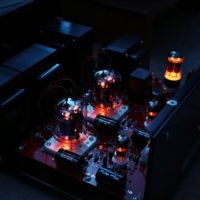 Finale Audio’s 829B Special (designed and made in Canada) is a very aptly named beast. By virtue of being the only production amp I know of that employs the 829B transmitting tube for power output, it’s automatically “special”. But apart from it’s lovely design, and an internal layout that almost screams for a plexi moonroof so you can gawk at it more often, this amplifier just begs to be heard. I don’t know how many single ended tube amps I’ve used or listened to over the years, but I’ve had some nice ones. And in every meaningful way I can think of, the Finale 829B Special surpasses them all. Yes, I said that out loud. If I somehow could have bought it, and still remained happily married, this amp would have stayed with me forever. It’s that wonderful.
Finale Audio’s 829B Special (designed and made in Canada) is a very aptly named beast. By virtue of being the only production amp I know of that employs the 829B transmitting tube for power output, it’s automatically “special”. But apart from it’s lovely design, and an internal layout that almost screams for a plexi moonroof so you can gawk at it more often, this amplifier just begs to be heard. I don’t know how many single ended tube amps I’ve used or listened to over the years, but I’ve had some nice ones. And in every meaningful way I can think of, the Finale 829B Special surpasses them all. Yes, I said that out loud. If I somehow could have bought it, and still remained happily married, this amp would have stayed with me forever. It’s that wonderful.
Triode heads who wanted single-ended purity with “mo powah” have long looked to the 845, 211, and a small handful of other (even rarer) power tubes. I’ve never quite cottoned to the 845 SET sound, personally. It could be I’ve just never heard one that had really good output transformers, or mated with the right speakers, but 845’s just aren’t high on my list. Meanwhile, 211-based amps tend to be quite expensive – a small pack led by the infamous Audio Note Ongaku. And all these brutes run incredibly, dangerously high voltages.
Enter the 829B, a tube I knew nothing about before Frank Ng announced this amp on Finale’s blog page. Hailing from the World War II era, it was found in many military VHF radios and also in Radar Pulse modulator service. They were also in WWII USA aircraft. Many tube-era amateur Ham and radio books included 829b projects. Very durable and long lasting, many ran 24/7. The Univac computer used them, and they were rumoured to be in MIT’s “Whirlwind” computer.
With this tube there are essentially 2 tetrodes housed within the same bottle. The 2nd harmonics can run higher than typical audio tubes, and must not be overlooked in the circuit design. The 829B is very similar to the GU29 and FU29 – and to the likely original 3E29. It evolved from the smaller 832. There are still substantial WWII surplus stocks, so even a pair of the very best will cost less than one 2A3, for instance. They can be run at much lower voltage than most transmitting tubes, so power transformers, output transformers and capacitors are less costly, and more plentiful.
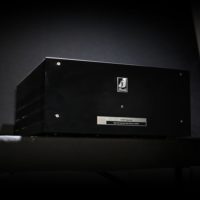 So what do we end up with? Well, in this case, you get 18 glorious, single-ended watts per channel, which sound like more – a lot more. The authority and control of the 829B Special is unlike any SET amp I’ve heard. It never sounded ruffled, distorted or anywhere near clipping. Sweet, smooth, balanced, clean. Powerful. The sound is muscular – it’s just about the perfect amp for someone with modestly efficient speakers, say 89dB or higher. And believe me, this amp will rise to the occasion if you have a great speaker in the house. One morning, Jon Eben Field and Frank Fazzalari were over, and we listened to some orchestral music on Frank’s Coherent Audio Model 15’s, which were here for a week before going to Jon Eben’s place for review. After a while I said, you guys need to hear this 829B amp. Holy Mother of God. We heard orchestras and kettle drums and lights, we heard things from beyond the great beyond. We heard the music. There were “WOW”‘s aplenty, and I believe Frank said he’d never heard his 15’s sound better. Soon my wife was calling from upstairs to see if everything was ok. I think it must have been the clatter of all those jaws dropping to the floor!
So what do we end up with? Well, in this case, you get 18 glorious, single-ended watts per channel, which sound like more – a lot more. The authority and control of the 829B Special is unlike any SET amp I’ve heard. It never sounded ruffled, distorted or anywhere near clipping. Sweet, smooth, balanced, clean. Powerful. The sound is muscular – it’s just about the perfect amp for someone with modestly efficient speakers, say 89dB or higher. And believe me, this amp will rise to the occasion if you have a great speaker in the house. One morning, Jon Eben Field and Frank Fazzalari were over, and we listened to some orchestral music on Frank’s Coherent Audio Model 15’s, which were here for a week before going to Jon Eben’s place for review. After a while I said, you guys need to hear this 829B amp. Holy Mother of God. We heard orchestras and kettle drums and lights, we heard things from beyond the great beyond. We heard the music. There were “WOW”‘s aplenty, and I believe Frank said he’d never heard his 15’s sound better. Soon my wife was calling from upstairs to see if everything was ok. I think it must have been the clatter of all those jaws dropping to the floor!
I had similar experiences when pairing the 829B Special with Reference 3A’s brilliant new Reflector. Quite a stunning combination that was! The 3A’s were pretty easy to drive with almost anything, but they really seemed to come alive with these bigger amps. The 829B proved to be “just enough” to muscle the Reflectors – the lower-powered amps sounded very good, but the 829B was stellar: again, the sense of authority and control tipped this over into the realm of a truly “high end” listening experience. And this same effect was played out, maybe even moreso, with my Radian coaxials, which are pretty sensitive, but still seem to benefit noticeably when driven with more wattage. Put it this way, when Frank’s 15’s went bye bye, the 829B Special made my considerably-lesser Radians sound so good that I was happy rather than sad.
With gear of this calibre, it becomes harder to describe what it is we enjoy. This was not the case with the Finale: rather than focus on minor aspects or supporting details, it was always the overall musical experience that came through. Music was performed with gusto, in a joyful, effortless way. While the 829B was here, I was reviewing a lot of other gear, and every time I had a chance to hook up this amp, I’d want to start giggling like a schoolgirl. Does it do everything? Probably not. If your leaning is to heavily compressed pop music, you might still need more power to unlock the bass beats. But I’m thinking of music that may not sound good on any home audio equipment, due to being badly overproduced. For all the music I listen to on the home system – a pretty broad range – the Finale was outstanding. I can only implore WoS readers to make an effort to hear this amp for themselves. You won’t regret it.
~~~~~~
Now let’s fly from Toronto to Copenhagen, boys and girls….
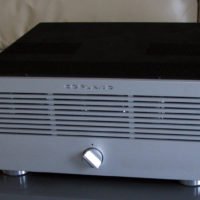 Copland’s CTA-506 is, quite simply, a hell of a power amplifier. Beautifully built, it feels solid and purposeful – this thing seems to whisper, “I’m the last amp you’ll ever buy.” Denmark is like a disproportional hub of fine audio companies, and Copland ranks with the very finest. These guys know how to build great stuff. I only had the Copland amp for a couple of weeks, but I was very impressed by it. Anyone in the market for a big tube amp along the lines of an Audio Research, or Atma-Sphere, should really consider this amp as well. This 90wpc amp uses 12 tubes, features massive transformers in the power supply and output stages, and weighs close to 60 lbs. Like the Finale, it clearly has a masterful internal layout, that should be seen and appreciated. But how does it sound, you ask?
Copland’s CTA-506 is, quite simply, a hell of a power amplifier. Beautifully built, it feels solid and purposeful – this thing seems to whisper, “I’m the last amp you’ll ever buy.” Denmark is like a disproportional hub of fine audio companies, and Copland ranks with the very finest. These guys know how to build great stuff. I only had the Copland amp for a couple of weeks, but I was very impressed by it. Anyone in the market for a big tube amp along the lines of an Audio Research, or Atma-Sphere, should really consider this amp as well. This 90wpc amp uses 12 tubes, features massive transformers in the power supply and output stages, and weighs close to 60 lbs. Like the Finale, it clearly has a masterful internal layout, that should be seen and appreciated. But how does it sound, you ask?
This is the first time I can honestly say that I fully enjoyed the KT120 push-pull sound. Copland is driving the KT120’s conservatively, meaning they’re going for increased headroom more than outright grunt. The result is an amp with a lot of dynamic capability. Maybe not enough current to drive the most demanding low impedance speakers, but for a user like me, it’s more power than I could imagine using in my room. This comes through as an effortless ease and “largeness” in the musical presentation. With all kinds of “big music”, the CTA-506 delivers a refined, exciting sense of the performance. If you play lots of Mahler, or orchestral Beethoven, the Copland will fill your room like no other tube amp I’ve spent intimate time with. And it’ll do it all day without breaking a sweat.
But it wasn’t just great with large scale music, like classical or big band jazz. The Copland was a quick partner to any great recording you’d care to throw its way. And to its credit, it never sounded like overkill. It just loped along effortlessly, relaxed, and seemed perfectly happy, playing Nick Drake, or John Lewis. These just weren’t the discs where the CTA506 made its most compelling statements. While the Copland’s midrange was generously supple, it wasn’t quite as sweet or coherent as a refined, single-ended beast like the Finale. Not hugely less so, but noticeably. That’s ultimately the difference to choose between: the Finale is a little more seductive, the Copland has a little more punch. I think the verdict on “which sounds better” largely comes down to how easy or hard your speakers are to drive, and to an extent, whether you’re playing a lot of complex music on ‘demanding’ speakers. If you do the latter, the Copland will wake up instantly, and show you its m.o.
~~~~~~
So which of these amps did I prefer? That’s a tough one – I liked them both immensely. If you need a lot of horsepower and tank-like build quality, the Copland is well worth checking out. Overall, for my tastes and needs, I would choose the Finale 829B Special: it has all the power I need or want, combined with the finesse, subtleties and holographic abilities of a low-power SET. It’s also quieter than the Copland (less self-noise). That’s a “special” combination of attributes, and it doesn’t really get any better than that, for me.
Finale Audio 829B Special, $10,829 US
http://www.finaleaudio.com/829b-special/
Loan courtesy of Finale Audio
Copland CTA-506, $6500 US
http://www.divertech.com/copland.html
Loan courtesy of Divergent Technologies


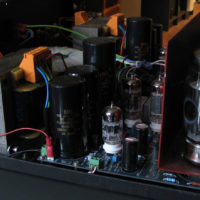
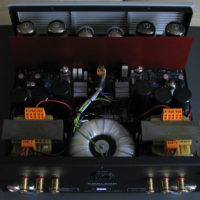
Hello. I’m curious about the sound on this amp vs the LM 518. Thanks!